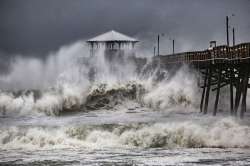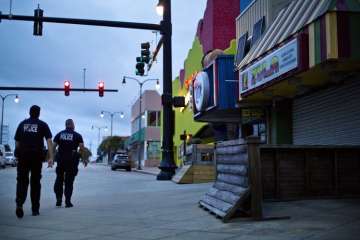Hurricane Florence batters parts of Carolinas, forecasters predict heavy rains and floods over next weekend
Forecasters said conditions will only get more lethal as the storm smashes ashore early Friday near the North Carolina-South Carolina line and crawls slowly inland.

Hurricane Florence battered the Carolina Coast on Thursday, bending trees and hooting frothy sea water over streets on the Outer Banks, as the hulking storm closed in with 100 mph (155 kph) winds for a drenching siege that could last all weekend. More than ten thousands of people were left without power.
Forecasters said conditions will only get more lethal as the storm smashes ashore early Friday near the North Carolina-South Carolina line and crawls slowly inland. Its surge could cover all but a sliver of the Carolina coast under as much as 11 feet (3.4 meters) of ocean water, and days of downpours could unload more than 3 feet (0.9 meters) of rain, touching off severe flooding.
Florence’s winds weakened as it drew closer to land, dropping from a peak of 140 mph (225 kph) earlier in the week, and the hurricane was downgraded from a terrifying Category 4 to a 2.
But North Carolina Governor Roy Cooper warned: “Don’t relax, don’t get complacent. Stay on guard. This is a powerful storm that can kill. Today the threat becomes a reality.”
More than 80,000 people were already without power as the storm approached, and more than 12,000 were in shelters. Another 400 people were in shelters in Virginia, where forecasts were less dire.

Forecasters said that given the storm’s size and sluggish track, it could cause epic damage akin to what the Houston area saw during Hurricane Harvey just over a year ago, with floodwaters swamping homes and businesses and washing over industrial waste sites and hog-manure ponds.
“It truly is really about the whole size of this storm,” National Hurricane Center Director Ken Graham said. “The larger and the slower the storm is, the greater the threat and the impact — and we have that.”
The hurricane was seen as a major test for the Federal Emergency Management Agency, which was heavily criticized as sluggish and unprepared for Hurricane Maria in Puerto Rico last year.
As Florence drew near, President Donald Trump tweeted that FEMA and first responders are “supplied and ready,” and he disputed the official conclusion that nearly 3,000 people died in Puerto Rico, claiming the figure was a Democratic plot to make him look bad.
Schools and businesses closed as far south as Georgia, airlines canceled more than 1,500 flights, and coastal towns in the Carolinas were largely emptied out.
Forecasters’ European climate model is predicting 2 trillion to 11 trillion gallons of rain will fall on North Carolina over the next week, according to meteorologist Ryan Maue of weathermodels.com. That’s enough water to fill the Empire State Building nearly 40,000 times.
More than 1.7 million people in the Carolinas and Virginia were warned to evacuate over the past few days, and the homes of about 10 million were under watches or warnings for the hurricane or tropical storm conditions.
Homeless after losing her job at Walmart three months ago, 25-year-old Brittany Jones went to a storm shelter at a high school near Raleigh. She said a hurricane has a way of bringing everyone to the same level.
“It doesn’t matter how much money you have or how many generators you have if you can’t get gas,” she said. “Whether you have a house or not, when the storm comes it will bring everyone together. A storm can come and wipe your house out overnight.”
Duke Energy Co. said Florence could knock out electricity to three-quarters of its 4 million customers in the Carolinas, and outages could last for weeks. Workers are being brought in from the Midwest and Florida to help in the storm’s aftermath, it said.
Scientists said it is too soon to say what role, if any, global warming played in the storm. But previous research has shown that the strongest hurricanes are getting wetter, more intense and intensifying faster because of human-caused climate change.
